Charcuterie boards are all the rage right now, but can we get clear on exactly what is a charcuterie board? Few people are actually using the term “charcuterie” correctly, so I’m here to set the record straight and show you how to make an authentic charcuterie board.
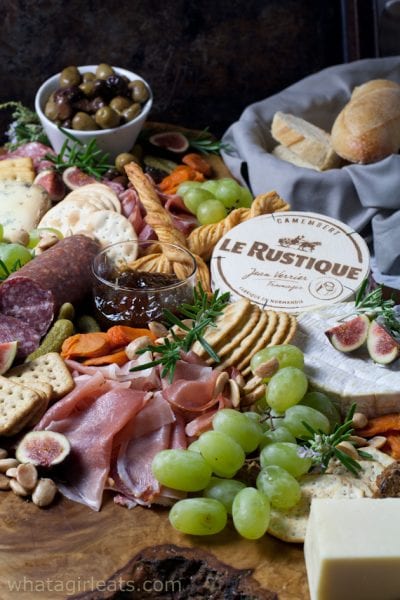
What Does Charcuterie Mean?
The word “charcuterie” (pronounced shaar-KOO-tr-ee) is French. It’s a noun and it can have two meanings.
In France, it will be the shop that you visit to buy cured meats, sausages, salami, pâté, galantines and rillettes. While most charcuterie products are made of pork, you’ll find all types of cured meats in a charcuterie.
The second charcuterie definition refers to the actual meat. A charcuterie board is one that is filled with cured meats, pâtés and various other meat products, as well as anything you serve with meat, such as olives, gherkins and pickled vegetables, and of course crackers or crusty bread.
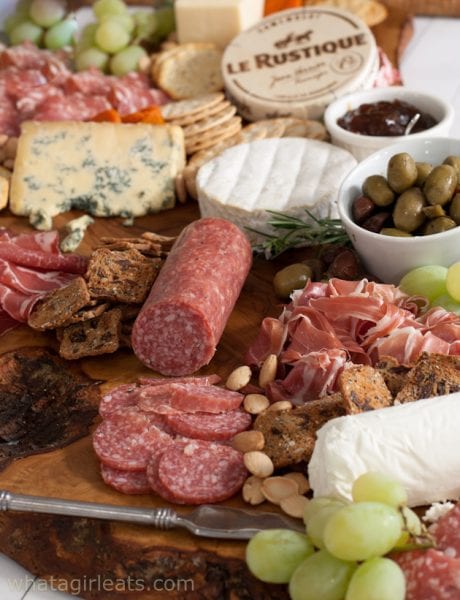
What is Charcuterie vs a Grazing Board?
Since the rise in popularity of these colorful boards over the last few years, the internet has been flooded with “charcuterie” boards that have no place using that name.
A grazing board is a great catch-all term for anything that doesn’t include MEAT.
A hot chocolate grazing board is a nice idea, but you can’t call it a “hot chocolate charcuterie board.” Substitute the word “meat” for “charcuterie” and you’ll see how silly it sounds: Hot Chocolate MEAT Board. Huh?
I’ve seen Christmas cookie charcuterie boards, waffle and pancake charcuterie boards, I’ve even seen VEGAN charcuterie boards – that one really makes no sense!
Even if you don’t speak French, nearly everyone knows what a chauffeur is. Aperitif, baguette, souffle, and vinaigrette are all words we’ve adopted from the French language. Charcuterie should be no different.
So go ahead and make a beautiful Hot Chocolate Board or a gorgeous Christmas Dessert Grazing Board, but just don’t call it a charcuterie board.
So now that we know what a charcuterie board is and isn’t, let’s answer the question, “What is a charcuterie board made of?”
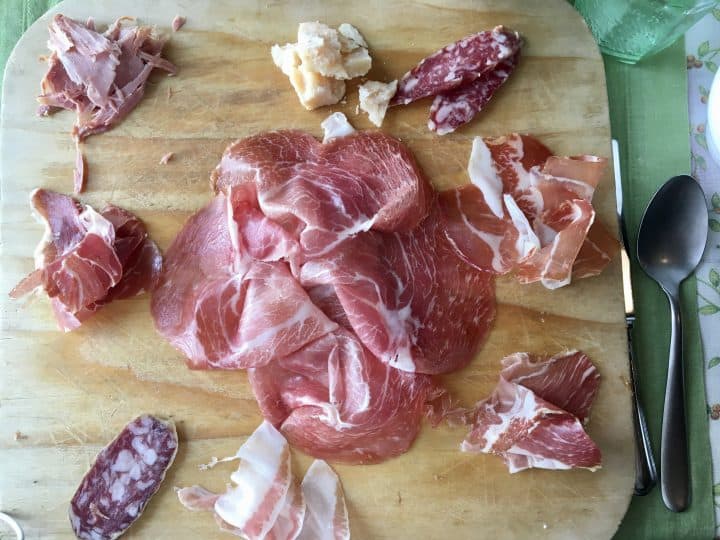
What Goes On a Charcuterie Board
While charcuterie is traditionally served on a wooden board, there’s nothing that says you have to use one. I’ve used cutting boards or even large platters.
Size matters though. Even if you’re making a small board for only six to eight people, use a large platter so you can fill it with the extras. Abundance is what makes a board look really impressive.
This is my favorite olive wood board. But here’s a budget friendly wooden board that would also make a lovely presentation.
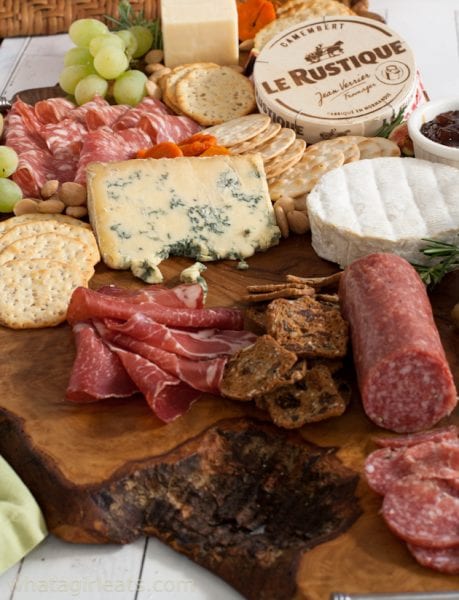
How much meat and cheese per person?
This is entirely subjective. Before you try to figure the amount of charcuterie meats per person, answer these questions:
- Is this going to be the centerpiece of a cocktail party, or just one component of a larger buffet table?
- Will there also be passed hors d’oeuvres?
- Will it be the only thing to eat at a wine tasting, or served in the middle of the afternoon between meals?
After you’ve decided when and how you’ll be serving your board, figure on 1 to 2 ounces of both meat and cheese per person.
Choosing the meats and cheeses.
Even if it’s a small group, I still like a variety. So that just means I’ll choose smaller amounts of everything.
A blue cheese like Roquefort, Stilton or Gorgonzola, is always a popular choice. A small (or large) wheel of brie or Camembert makes an excellent centerpiece. Goat cheese blends well with prosciutto and fig jam, and a sharp English cheddar, Spanish Manchego, or Dutch Gouda would make your board very continental.
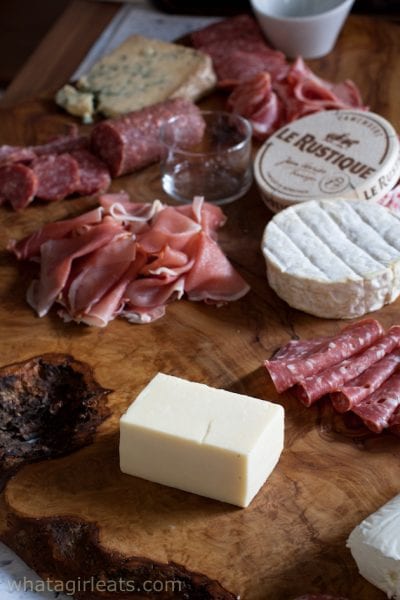
In addition to a variety of sausage and salami, speck, and pâtés, this Smoked Trout Mousse could be served as well.
Prosciutto is a lovely addition to a board. Last year I traveled to Italy and was able to visit an ethical agriturismo that produces some of the best prosciutto in the world. You can read about Antica Corte Pallavicina here. And Christina’s Cucina has a great post on how prosciutto is cured.
What else goes on an authentic charcuterie board?
Most boards usually contain dried fruits, olives, nuts, gherkins, and a sweet spread like honey, or fig jam. To keep it classic, serve the hummus, and other spreads and dips separately.
You’ll also want to include different types of crackers, and perhaps a baguette of bread, depending on the intention of the meal. If the board is meant to substitute for a light lunch, serve a couple of interesting breads. Omit the bread if it’s for a cocktail party or more elegant event.
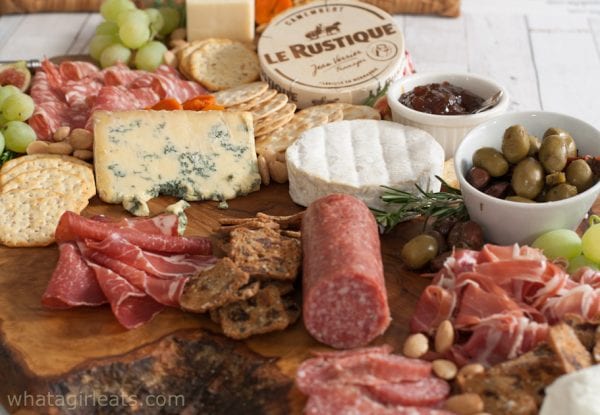
Building a Beautiful Charcuterie Board
Designing a beautiful charcuterie board is half the fun!
Start by laying out all the cheeses and meats. I like to have them in varying sizes for visual appeal. Usually Brie or Camembert will come in a rustic box which is a nice anchor.
After I’ve placed all the main components around the board, and I’m pleased with how it looks, I’ll add the extras, like a small bowl of olives and something sweet like honey or jam.
Dried fruit and nuts can be layered next. Add green or red grapes cut into manageable pieces. I like to imagine how many grapes someone might want. They can be layered to look like a bigger bunch.
Think of colors when choosing grapes. With a lot of dark meats, I like to add a pop of green.
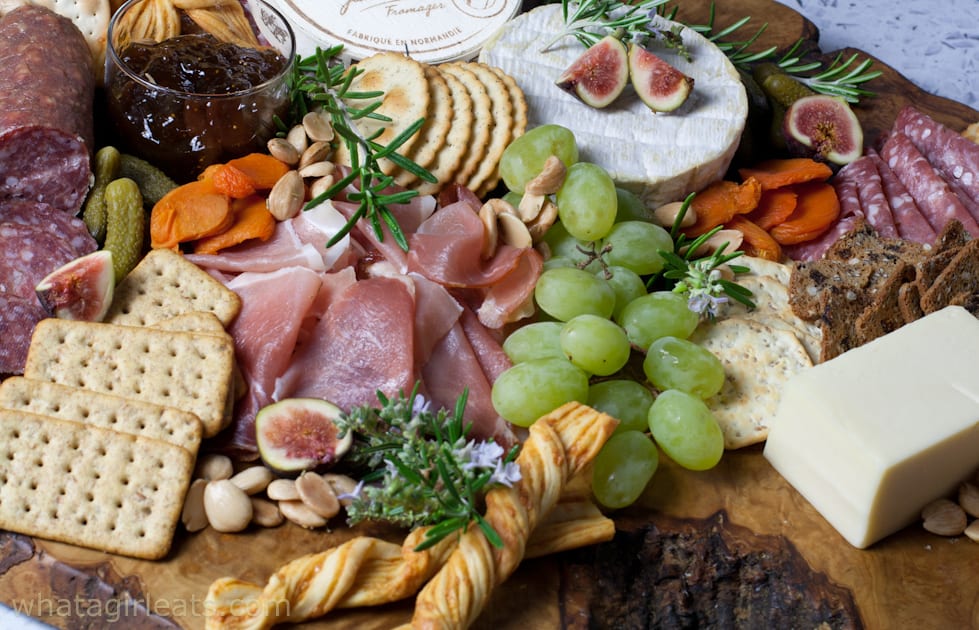
Next, tuck crackers in all the empty spaces.
Finally, add sprigs of fresh herbs. BUT nothing should go on a board that isn’t edible, so don’t add holly because it’s festive. It’s also poisonous.
Assembling a charcuterie board is one of the most relaxing jobs, it’s almost like making art, no two are ever alike!
Charcuterie Board
Ingredients
The Meat
- 8 ounces prosciutto thinly sliced
- 8 ounces salami sliced
- 8 ounces sopressata sliced
- 8 ounces capicola thinly sliced
Cheese
- 8 ounces brie or camembert
- 8 ounces blue cheese stilton, roquefort or gorgonzola
- 8 ounces goat cheese
- 8 ounces cheddar
The Extras
- 4 ounces gherkins drained
- 6 ounces olives packed in olive oil, drained
- 6 ounces almonds
- 4 ounces fig jam
- 4 ounces dried apricots
- 8 ounces green grapes
- 2 figs quartered or halved for garnish
Instructions
- For best results, place all the meats and cheeses first. Decide on a pleasing arrangement. Space the meats and cheeses.
- small containers of olives or jams
- Next add the crackers, dried fruit and small bunches of grapes.
- Scatter nuts and tuck sprigs of rosemary into the crevices. Finish by garnishing with fig wedges.
Notes
- Choose a variety of meats and cheeses, even if your gathering is smaller.
- Choose a lighter jam, like apricot for the spring or summer.
- Add a variety of crackers.
- Allow about 4 ounces of meats and cheeses (Combined) for a cocktail party if the board will just one of the items served.

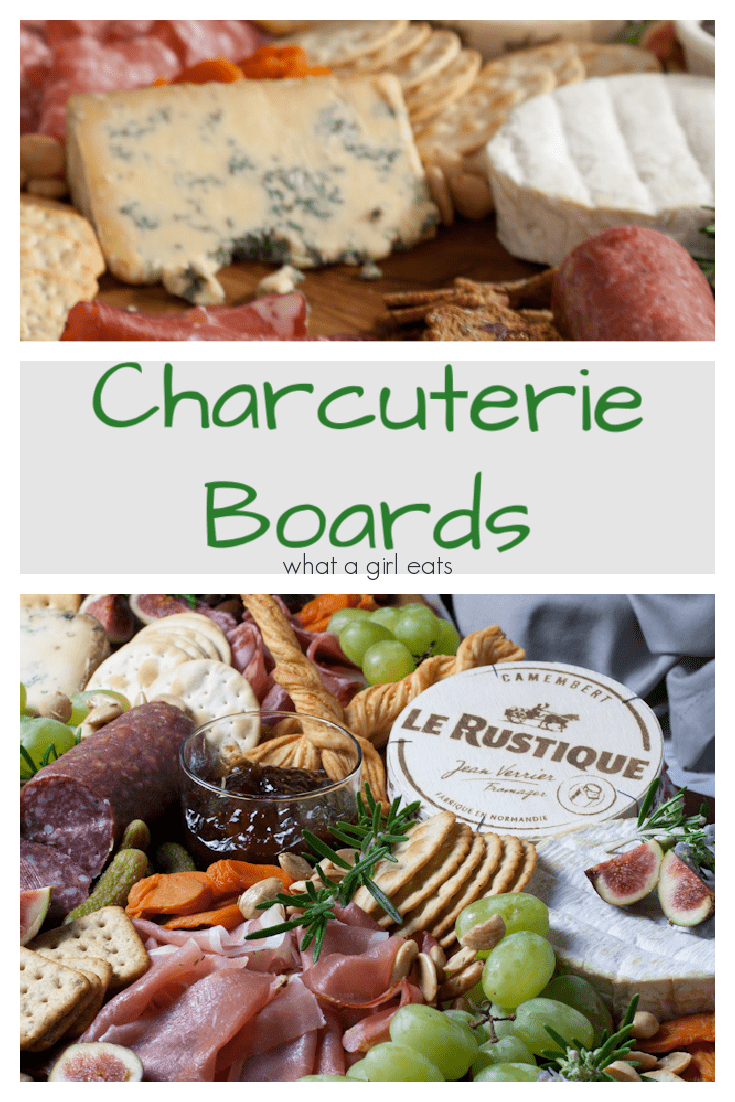
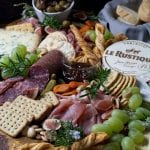


Christina Conte says
Hear hear! My mind explodes when I see a “cookie charcuterie platter” or like you mentioned, a “vegan charcuterie board”! I think lots of people need to read this post! Thanks for sharing the correct information!
Dan "Jay" Reyes says
This foodie pictures looks so appetizing and make me hungry!
Cynthia says
thank you Dan!
Jere Cassidy says
Great post and explanation. I love cured meats and cheeses and your board looks so appetizing.
Chef Mimi says
I hope people read this! Someone was insulted once when I suggested she change the name of her post – she had a charcuterie board, with only cheese! I don’t want to be an annoying blogger, but when things are wrong, the most likely young bloggers should learn. Love this post!
Lucy says
Willingness to accept information and advice seems to have dwindled in recent years! Instead everyone is “offended”. How can you be offended if someone tells you you’re wearing your clothes inside out and backwards!!? This is the same thing!
Cynthia says
right? Someone said, “it’s kind of come to mean ANY grazing board”. I replied, people know what a chauffeur, a limousine, souffle and baguette are, why can’t they learn a new word for MEAT?
Cynthia says
thanks Mimi. What’s with that? I think people see something on social media and THINK they know what it means without bothering to do a simple Google search! You’ve probably seen just as many crazy “charcuterie” boards as I have!
Chef Mimi says
Since your post, I’ve corrected someone’s spelling of chile peppers (she’s American) and also someone incorrect use of au jus. You’d really have to know French to understand that one doesn’t “put the of jus in a bowl,” but still, as bloggers I think we need to be relied on for correct information. #1 person didn’t change her spelling and removed my comment, #2 guy told me “he could have said it differently,” like I was rude, but hasn’t changed his wording. I dunno…
Cynthia says
right Mimi? Chile, chili, two completely different things…and then there’s Chile! which autocorrect always wants to add a flag to!
Shashi says
Charcuterie boards are our dinner of choice on New Years eve – though sometimes I get lazy and settle for a cheese and cracker bard! Btw- I love your tips and classifications.
Cynthia says
Thank you! cheese always works for a meal!
Patty at Spoonabilities says
Such a delicious spread of the most amazing meats and cheeses!
Cynthia says
Thank you!
Irina says
OMG! I have learned so much from reading your post. It is amazing, and I now feel like a pro of charcuterie boards!
Cynthia says
Thank you! They are so fun!
Kushigalu says
What a useful post. You have shared the corect iNformation on charcuterie. I hope people read this
Cynthia says
Thank you! There is a lot of mis-information!
Monidipa says
The recipe sounds really great and truly it is worth a try. And I will give it a try.
Cynthia says
Thank you! I’ve been making it this way for over 40 years. Simple is sometimes best.
Eloise says
that display of food looks so tasty! I’m french so my family eats this kind of food often. great meat! yum!
Marta says
Now I am really confused! First of all it is “cured meats, pâtés and various other meat products”. Then, all of a sudden it adds cheese. Cheese is not a meat product. It is alright to add meat accoutrements, but cheese?? It does make the board look good but it is not charcuterie, not MEAT or products of meat. When I lived in the UK charcuterie meant meat and basically meats only, along with accoutrements, such as grapes, crackers and sliced baguettes. Is the cheese something new that can now be added to a charcuterie board?
thanks
Cynthia says
you bring up a valid point. I think I explained “charcuterie” in my post. I’ve added cheese as an accompaniment to the charcuterie, but you certainly can stick with just various types of meats. In France and Italy (as shown in the photo) usually a small amount of cheese accompanies the meats. My objection to the word “charcuterie” is when it’s used for a variety of desserts, breakfast items, “vegan” or other things which have nothing to do with charcuterie. If I were preparing a “cheese board”, I might put a small amount of meat as well as other accoutrements, but with the emphasis on cheeses.
Jill Colonna says
I love that you’ve shared this about charcuterie boards, Cynthia! Spot on. In France, everyone knows what it is and so we don’t think about it much but lately on the internet I’ve seen these crazy boards of sweet treats with everything except cured meats and hams, calling it charcuterie. I haven’t even heard of a grazing board! Thanks for passing on the right information – will be sharing as THE voice on these platters!
Rehoboth says
Nice post
doodle jump says
Thanks for passing on the right information – will be sharing as THE voice on these platters!
Laurie AL says
I’m confused, and I’m sure it’s my interpretation, no fault of yours. When figuring how much to serve per person, you say about 2 ounces EACH cheese and meats. Is that when it’s just a nosh board, when it’s served with other appetizers, or when its part of or before or after a meal? Or do you just add breads to bulk it up for more substance? I can’t make sense of this otherwise great post.
Also, are the gherkins sweet or dilled? I’m Canadian, in a moderately large-sized city, and I’d never heard of sour gherkins until a trip to the U.S. Now I always wonder.
Help!
Cynthia says
Those are all great questions. I will clarify in the post as best as I can. For me, it’s super subjective. It depends on the time of day, will there be other food? Is it going to be the main meal for most? Is your crowd couples with men, or is it a group of ladies for pre-dinner drinks? I think of it like this, 4 ounces of meat and cheese would be an average sized sandwich. Regarding the gherkins,they can be either sweet or savory. Cornichons are like gherkins, but they’re only savory.
Alice Carroll says
Thanks for the reminder that having a variety of sizes will also make charcuterie boards more appealing to look at. I’d like to have charcuterie boards for a party I will be hosting soon. I think that will be great as some sort of appetizer before the bigger dishes will be served.
Terry says
Wow! Christina, thank you for your expertise and wonderful collection of recipes and the “How to’s”.”
Now I truly know how to build a Charcuterie Board with confidence and all the “right stuff.”
Your recipes are my go to for everyday or company. One of my many favorites is your Scottish Snow Cake. I made it for Christmas Day. My nephew just finished a semester at Edinburgh College. It was truly a hit and delicious, Many thanks for all you are.
Cynthia says
thanks Terry, but my name is Cynthia.I think you’re thinking of my friend Christina? She has a snow cake recipe.